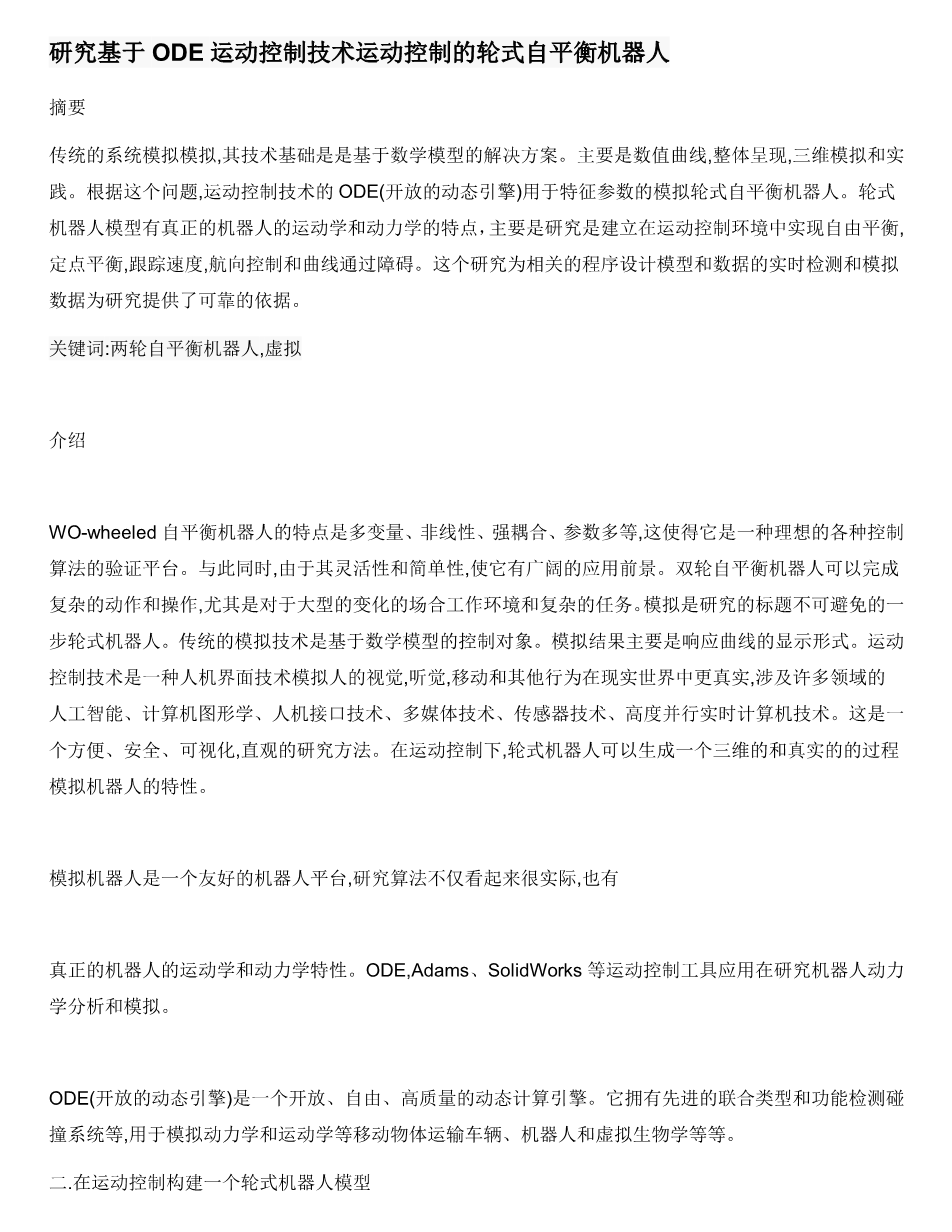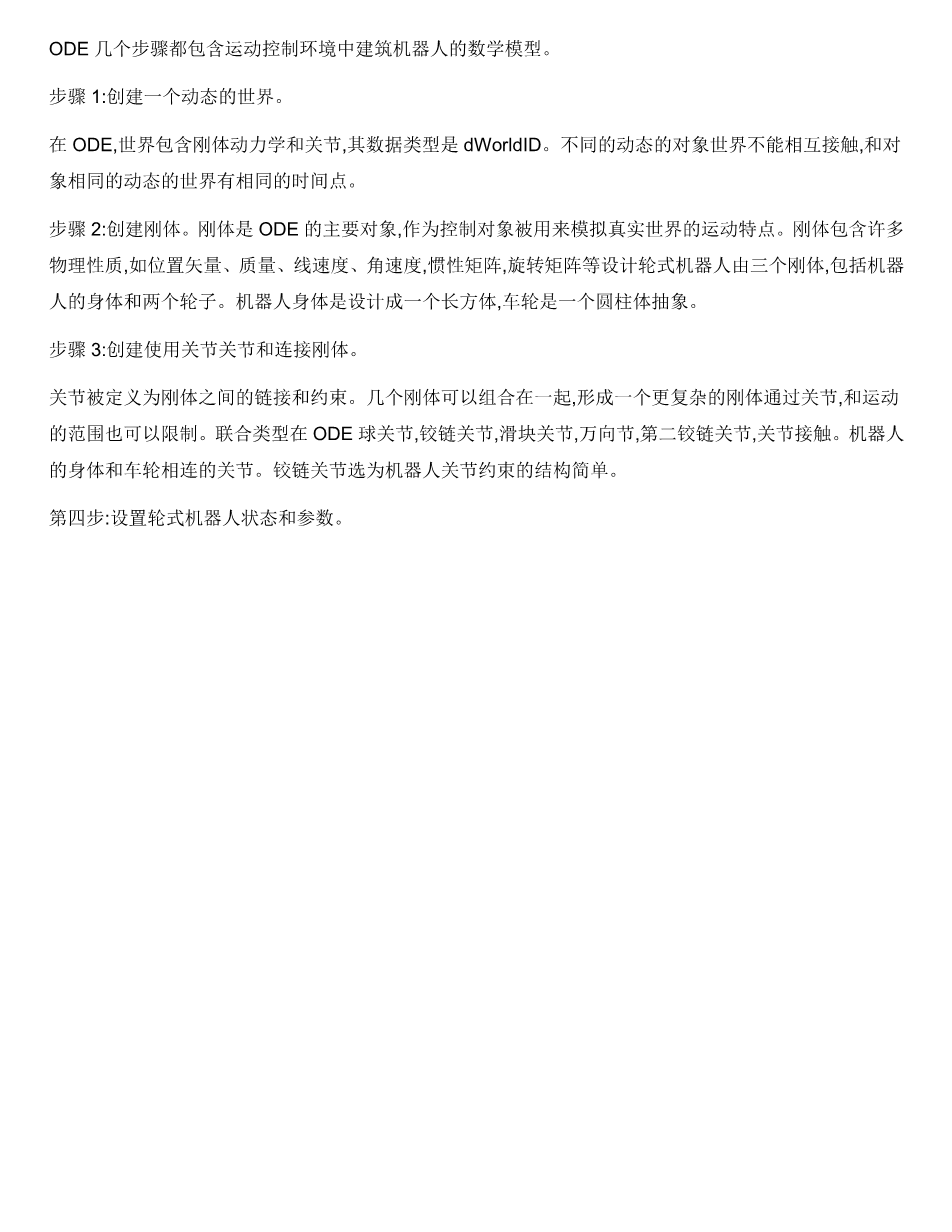Abstract—The simulation results of traditional system simulation, whose technology is based on the solution of mathematical model, are mostly numerical curve, lack of telepresence, third dimension and immersive. According to this problem, virtual reality technology ODE (Open Dynamics Engine) is used for the simulation of characteristic parameters on wheeled self-balancing robot. A wheeled robot model
having the feature of real robots kinematics and dynamics has been built in virtual reality environment to achieve free balance, fixed-point balance, speed tracking, heading control and linear obstacle negotiating. And related procedures have been designed for real-time detection of model parameters and export of simulation data which provide a reliable basis for the experimental study.
Key words: Two-wheeled self-balancing robot; Virtual
reality; Motion control
I. INTRODUCTION
WO-wheeled self-balancing robot has the characteristics of multivariable, nonlinear, strong coupling and parameter , etc. This makes it is an ideal verification platform for a variety of control algorithms. Meanwhile, due to its flexibility and simplicity, it has broad application prospects. Two-wheeled self-balancing robot can complete the complicated movements and operations, especially for the occasions of large changes in the working environment and complex tasks. Simulation is inevitably step in the heading of the study wheeled robot. Traditional simulation technology is based on mathematical model of controlled object, and simulation results are mostly shown in the form of response curve. Virtual reality technology is a man-machine interface technology simulating humans vision, hearing, moving and other acts in the real world more realistically, involving many fields of artificial intelligence, computer graphics, human-machine interface technology, multimedia technology, sensor technology, and highly parallel real-time computer technology. It is a convenient, safe, visual, intuitionistic research method. Under the virtual reality, wheeled robot can generate a strong telepresence, third dimension and immersive in the process of simulation through simulation of the robots characteristic parameters.
The simulation robot is a friendly robot platform for study algorithm which not only looks great realistic, but also has
the feature of real robots kinematics and dynamics. ODE, Adams, SolidWorks and other virtual reality tools are applied to analysis and simulation in study robot dynamics.
ODE (Open Dynamics Engine) is an open, free, high quality dynamic calculation engine. It has advanced joint types and
functions to detect collision systems, etc. which is used to simulate dynamics and kinematics of moving objects such as
transportation vehicles, robots and virtual biology etc.
II. BUILD A WHEELED ROBOT MODEL IN VIRTUAL REALITY
ODE Several steps are included in building the mathematical model of the robot in virtual reality environment.
Step 1: Create a dynamic world.
In the ODE, the dynamics world contains rigid bodies and joints, whose data type is dWorldID. Objects of different dynamic worlds can not touch each other, and objects of the same dynamic world have the same time point.
Step 2: Create rigid bodies. Rigid body is the main object of ODE, and as the control object was used to simulate the motion characteristics of real world. A rigid body contains many physical properties, such as position vector, mass, linear velocity, angular velocity, inertia matrix, rotation matrix etc. The designed wheeled robot is composed of three rigid bodies, including the robot body and two wheels. The robot body is designed as a cuboid, and the wheels are abstracted to a cylinder.
Step 3: Create joints and connect rigid bodies using joints.
Joints are defined as the links and constraints between rigid bodies. Several rigid bodies can be combined together to form a more complex rigid body through the joints, and the range of motion can also be constrained. The joint types in the ODE are ball joint, hinge joint, slider joint, universal joints, hinge joints II, and contact joints. Robot body and the wheels are connected with the joints. Hinge joint is chosen as the robot joint constraints for its simple structure.
Step 4: Set wheeled robot status and parameters.
Kinetic parameters of wheeled self-balancing robot are designed according to the actual system, and as shown in Table
I. The geometry size of the robot in virtual reality
Through the above steps, the wheeled robot model in virtual reality environment is constructed and shown in figure 1.
III. MOTION CONTROL RESEARCH OF WHEELED ROBOT IN VIRTUAL REALITY ENVIRONMENT
A. Design Simulation experiment program in virtual reality environment
Take three-dimensional visualization model of the robot as the control object, and based on ODE program package to
implement the robot motion control.
First, initialize the system. In this step we have to set the initial conditions of the robot system. Second, in each simulation step, we need to detect and deal with the system collisions; and detect the robots posture and motion; then calculate the control torque according to the control algorithm to achieve the robots motion control; at last achieve dynamics simulation of physics engine and rendering and the 3D objects and scene.
For the three-dimensional dynamic simulation of robot system, second part should be calculated iteratively until reaches the simulation requirements or occurs an internal error, the dynamics world and the colli
剩余内容已隐藏,支付完成后下载完整资料


英语原文共 21 页,剩余内容已隐藏,支付完成后下载完整资料
资料编号:[152098],资料为PDF文档或Word文档,PDF文档可免费转换为Word
您可能感兴趣的文章
- 饮用水微生物群:一个全面的时空研究,以监测巴黎供水系统的水质外文翻译资料
- 步进电机控制和摩擦模型对复杂机械系统精确定位的影响外文翻译资料
- 具有温湿度控制的开式阴极PEM燃料电池性能的提升外文翻译资料
- 警报定时系统对驾驶员行为的影响:调查驾驶员信任的差异以及根据警报定时对警报的响应外文翻译资料
- 门禁系统的零知识认证解决方案外文翻译资料
- 车辆废气及室外环境中悬浮微粒中有机磷的含量—-个案研究外文翻译资料
- ZigBee协议对城市风力涡轮机的无线监控: 支持应用软件和传感器模块外文翻译资料
- ZigBee系统在医疗保健中提供位置信息和传感器数据传输的方案外文翻译资料
- 基于PLC的模糊控制器在污水处理系统中的应用外文翻译资料
- 光伏并联最大功率点跟踪系统独立应用程序外文翻译资料



